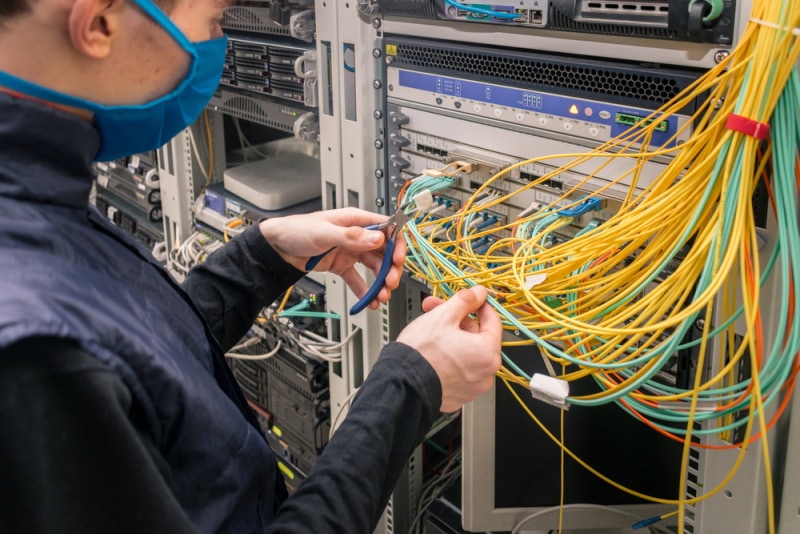Can You Splice Fiber Optic Cables? What to Know!
Last Updated on

Fiber optic cables hit the marketplace in 1975 and have made several advances ever since. It’s a type of network cable made up of either one or several optic fibers. These fibers can be used to transmit data between different devices.
Although it may look very similar to an electrical cable, fiber optic cables transmit light instead of electricity. They cost more than cable costs but are cheaper than copper wires and can transmit data at high speeds and long distances using light pulses. They’re widely used for many internet, cable TV, and telephone systems around the world.
Fiber optic cables have been growing in popularity in recent years because of the need to transmit data at a faster rate over a network. Fiber optic cables are capable of running at speeds up to 10, 40, and 100 Gbps (Gigabits per second). But can these cables be spliced? In short, yes, you can splice fiber optic cables.

So, Can You Splice Fiber Optic Cables?
Yes. You can splice fiber optic cables. Splicing is the procedure of removing the outer plastic cover of a cable and joining two or more conductors together to form a new mechanical or electric bond. Splicing is done either by crimping the cables or soldering them.
Most Common Uses for Fiber Optic Cables
Fiber optic cables offer convenience and high transmission speeds in everyday life and are used in a variety of applications. Let’s look at some of the most common ways that they’re used today.
Cable TV
Since their invention, fiber optic cables have been used to transmit cable signals. Because they’re ways faster and have greater bandwidth than many other cable types, fiber optic cables are perfect for signal transmission to HD Televisions. As mentioned earlier, these cables are also much cheaper than copper wires.

Automotive
Fiber optic cables are used to light both the exterior and interior of automobiles. They’re essential for safety and lighting. They can deliver superior light in a small space. Fiber optic cables allow signal transmission at high speeds between various parts of a car such as the ignition, dashboard controls, SMART features, and car alarms. This is why they are so valuable for safety applications.
Internet
Internet access is probably the most common application for these cables. Fiber optic cables can transport high data rates at high speeds and are lighter than traditional copper wiring. In the past few decades, fiber optic cables have become more popular as internet cables than other types of cables.
Computer Networking
Before their invention, many experts and engineers in the computer industry noticed a decrease in the time taken to transfer files and information between networks. The invention and use of fiber optic cables have made it easier to connect between different computer structures such as large computer networks and their corresponding servers.

Remote Sensing
The cables can be used to measure temperature, speed, and pressure. Modifying the fiber count allows them to modify the phase, intensity, and wavelength of the fiber. The cables are convenient for remote sensing because they don’t need electricity to function. They’re also safer and can be used in high-voltage or flammable areas.
Lighting & Decorations
These cables can also be used to light decorations and illuminate Christmas trees. Fiber optic cables have been used in more decorative structures over the years. They can be used to lighten up projects and are attractive, economical, and easy to install.
Healthcare
Fiber optic cables are used in medicine. Endoscopy, a non-invasive surgical method that uses optical communication, is a great example of optical communication. A small, bright light is used in this procedure to illuminate the area of surgery inside the body. This allows it to make fewer and smaller incisions. Fiber optics can also be used in microscopy and biomedical research.
Telecommunications
Modern technology makes it easy to call both within the US and internationally. We have fiber optic cables to thank for this. These cables speed up communication connections and allow for clearer phone conversations without any lags.

Top Benefits of Fiber Optic Cables
So, as you can see, there are quite a few uses of fiber optic cables, which is an understatement. Now let’s look at some of their main benefits in comparison to other standard cables.
1. Speed
Fiber optic ethernet speeds are beyond impressive and can currently achieve speeds up to 100 Gbps. This is about 10 to 20 times faster than the standard internet cables that most people know.
2. Reliability
Your cable connection should be fast enough for streaming video without interruptions, but not so fast that peak traffic overwhelms the wires. This is where the differences between fiber optic internet and cable speed become obvious. Fiber optics are able to handle more users and transmit more data at consistently higher speeds.
Also, internet connections with these cables don’t require energized lines so they’re less susceptible to outages than traditional cable internet. Fiber optic cable can continue delivering bits and bytes of data even if the lights go out, as long as it’s still intact.

3. Safety
Faster internet connections via fiber optic cable internet service or 5G are not just for entertainment, they will make the world safer. The National Broadband Plan created in 2010 by the FCC calls for better public safety and a stronger national network.
The plan is a mandate that establishes benchmarks for improved internet connections and data transfer in the US. For example, it states that first responders require faster and more reliable internet access to receive data, voice, or video in order to save lives.
It provides better notification during disasters and strengthens national security. It also ensures that faster telemedicine services will allow healthcare professionals to remotely diagnose, treat, and monitor patients. This is especially helpful to those with disabilities and the elderly living independently.
4. Same Upload and Download Speeds
Upload speeds and download speeds differ depending on how fast you use cable internet. This is essentially based on how users use the internet. The majority of users download more than they upload, so internet providers allocate most of their bandwidth for downloading.
Fiber optic internet speeds make slow internet uploads a thing of the past. Fiber optic-based internet providers are able to give equal consideration to downloads and uploads, as there is no risk of overloading the network. This type of internet service makes it easy to share files and work remotely.

5. Better Quality Television
Fiber optic cables are responsible for the popular “Ultra High Definition” capability of televisions. These TVs pack four times more pixels into the same area, which results in crisper images.
6. Gaming
Are you a League of Legends or Fortnite fanatic? Well, it’s another digital arena where fiber optic cables reign supreme. Gaming doesn’t require huge bandwidth and it uses a fraction of the bandwidth compared to streaming high-quality video streams.
But a small hiccup in your data access can mean the world when it comes to streaming video games. What’s the advantage of fiber optic cables? Reliability and consistency. There are many little problems with DSL or cable internet connections that can cause super-tiny hiccups in the connection.
Fiber optic internet providers ensure that data flows smoothly and continuously, so the game responds immediately whenever you touch your control–and it’s hiccup-free.

7. Multiple Device Connections
Another great benefit of fiber optic cables is that they allow you to connect multiple devices without losing any data or transmission speed. The days of the “household computer” are pretty much long gone. We now have many devices in our homes. These include laptops, smartphones, tablets, smartphones, home cameras, and smart thermostats.
With fiber optic internet service, you can connect to multiple devices, including laptops, cameras, and phones, using a steady signal that has less signal loss and offers 10-15 times more bandwidth. Fiber optics can also handle multiple streams of video and music simultaneously.

Final Thoughts
So, there you have it. Yes, fiber optic cables can be spliced using soda rain or cramping techniques. These cables provide a host of useful benefits to different areas in both business and personal uses.
Fiber optic cables were introduced in 1975 and since then have become the go-to data transmission source for internet services, cable television connections, telecommunication services, and entertainment devices.
Featured Image Credit: Maximumm, Shutterstock
About the Author Robert Sparks
Robert’s obsession with all things optical started early in life, when his optician father would bring home prototypes for Robert to play with. Nowadays, Robert is dedicated to helping others find the right optics for their needs. His hobbies include astronomy, astrophysics, and model building. Originally from Newark, NJ, he resides in Santa Fe, New Mexico, where the nighttime skies are filled with glittering stars.
Related Articles:
What Is the Best Binocular Magnification for Hunting? Optical Features Explained
Can You Use Binoculars to Look At Stars? How to Choose the Right Pair
How to Clean a Refractor Telescope: Step-by-Step Guide
How to Clean a Telescope Eyepiece: Step-by-Step Guide
How to Clean a Rifle Scope: 8 Expert Tips
Monocular vs Telescope: Differences Explained (With Pictures)
What Is a Monocular Used For? 8 Common Functions
How to Clean a Telescope Mirror: 8 Expert Tips
